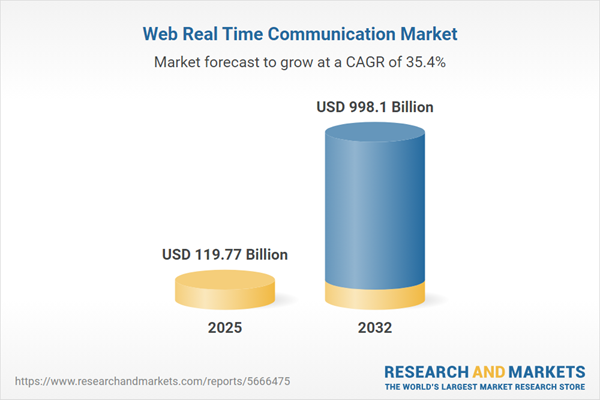Speak directly to the analyst to clarify any post sales queries you may have.
The Web Real Time Communication Market is rapidly transforming the digital interaction landscape, enabling seamless audio, video, and data exchanges that drive value across industries. As expectations for low latency, reliability, and security surge, organizations are embedding this technology into a wide array of enterprise functions, making real time communication a vital standard in operational infrastructure.
Market Snapshot: Web Real Time Communication Market Overview
The Web Real Time Communication Market grew from USD 88.41 billion in 2024 to USD 119.77 billion in 2025. It is expected to continue growing at a CAGR of 35.38%, reaching USD 998.10 billion by 2032. This growth is driven by the integration of real time technologies in sectors such as customer support, e-learning, healthcare, and immersive collaboration, while ongoing regulatory shifts and infrastructure investments shape the adoption landscape worldwide.
Scope & Segmentation
This research provides a comprehensive analysis of market segments, deployment modes, platforms, organizational scales, communication types, end user sectors, and regions:
- Component: Service (Managed Services, Professional Services); Solution (API & SDK, Protocols & Standards, Software Platforms)
- Deployment Mode: Cloud (Private Cloud, Public Cloud); On Premise (Dedicated, Self Hosted)
- Platform: Desktop, Mobile
- Organization Size: Large Enterprise, Small and Medium Enterprises
- Communication Mode: Audio, Data, Video
- End User Vertical: Banking, Financial Services and Insurance (BFSI); Healthcare; IT & Telecommunication; Media & Entertainment
- Regions Covered: Americas (including United States, Canada, Mexico, Brazil, Argentina, Chile, Colombia, Peru); Europe, Middle East & Africa (United Kingdom, Germany, France, Russia, Italy, Spain, Netherlands, Sweden, Poland, Switzerland, United Arab Emirates, Saudi Arabia, Qatar, Turkey, Israel, South Africa, Nigeria, Egypt, Kenya); Asia-Pacific (China, India, Japan, Australia, South Korea, Indonesia, Thailand, Malaysia, Singapore, Taiwan)
- Industry Leaders: Zoom Video Communications, Cisco Systems, Microsoft, Twilio, Google, Vonage, 8x8, Sinch, Agora, Pexip
Key Takeaways for Decision Makers
- The shift from proprietary plugins to open, standards-based solutions broadens real time communication accessibility and interoperability for enterprises and development teams.
- Platform choices between cloud, private, and on-premise deployments now influence security, compliance, and scalability strategies depending on industry and user needs.
- Integration of edge computing and 5G technologies supports ultra-low latency and reliability, which is essential for high-stakes use cases in healthcare, finance, and real time collaboration.
- AI and machine learning strengthen communication workflows through real time moderation, noise suppression, and adaptive optimization, ensuring performance across varying network environments.
- Heightened global data protection regulations are driving the adoption of robust encryption and flexible data governance frameworks, especially for region-specific compliance concerns.
- Modular, API-first architectures combined with rich developer resources are favored by customers seeking rapid deployment and innovation across diverse markets and applications.
Tariff Impact: Strategic Adjustments in the U.S. and Beyond
The 2025 introduction of U.S. tariffs on key hardware for real time communication has led organizations to reassess procurement and supply chain models. Enterprises are increasing regional manufacturing, while cloud providers adjust pricing strategies to maintain competitiveness. Technology vendors are accelerating the adoption of software-defined networking and virtualization, enabling solutions that are resilient to regulatory changes and hardware dependencies.
Methodology & Data Sources
This report is based on structured interviews with industry leaders, detailed secondary research from trusted databases, and analytical frameworks that validate technology and market trends. Quantitative analysis, scenario modeling, and stakeholder cross-verification ensure data integrity and relevance.
Why This Report Matters
- Enables senior leaders to benchmark technology strategies and navigate complex regulatory landscapes with actionable, segmented insights.
- Supports robust investment and go-to-market planning by detailing component, deployment, and regional growth opportunities across the real time communication value chain.
- Provides clarity on competitive positioning, partner ecosystems, and emerging trends to inform decision-making in a fast-evolving landscape.
Conclusion
Web Real Time Communication technologies are now core to digital business models across the globe. Organizations acting on interoperability, security, and developer enablement are best placed to advance customer engagement and operational efficiency in dynamic markets.
Additional Product Information:
- Purchase of this report includes 1 year online access with quarterly updates.
- This report can be updated on request. Please contact our Customer Experience team using the Ask a Question widget on our website.
Table of Contents
3. Executive Summary
4. Market Overview
7. Cumulative Impact of Artificial Intelligence 2025
Companies Mentioned
The companies profiled in this Web Real Time Communication market report include:- Zoom Video Communications, Inc.
- Cisco Systems, Inc.
- Microsoft Corporation
- Twilio Inc.
- Google LLC
- Vonage Holdings Corp.
- 8x8, Inc.
- Sinch AB
- Agora, Inc.
- Pexip ASA
Table Information
| Report Attribute | Details |
|---|---|
| No. of Pages | 196 |
| Published | October 2025 |
| Forecast Period | 2025 - 2032 |
| Estimated Market Value ( USD | $ 119.77 Billion |
| Forecasted Market Value ( USD | $ 998.1 Billion |
| Compound Annual Growth Rate | 35.3% |
| Regions Covered | Global |
| No. of Companies Mentioned | 11 |









